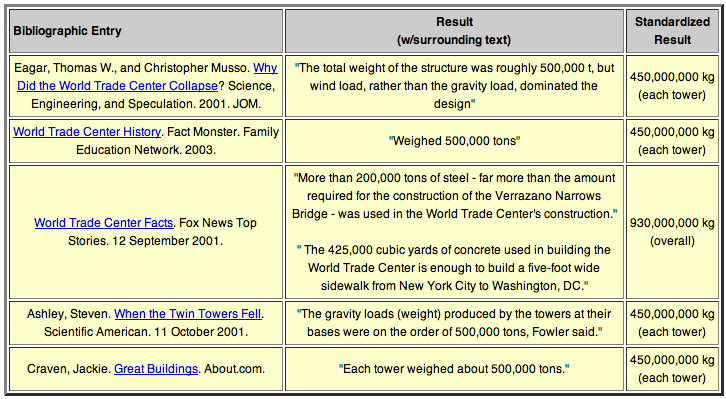Greening:
"Published data /11/ on the kinetics of the reduction of calcium sulfate indicate that about 0.1 % per minute
conversion to SO2 would occur for CaSO4 maintained at 900C in an atmosphere containing 1 % CO.
If we assume that similar temperature and carbon monoxide impurity concentrations prevailed for 30
minutes in the combustion gases from the WTC fires, about 240 kg of SO2 would have been released
within each WTC Tower by decomposition of gypsum wallboard."
So, to get 3% SO2 from the wallboard, which would be dispersed over the surface area in which the hot gases formed in contact with the wallboard, even the most generous interpretation of the available data says that temps need to be at
900C for 30 minutes. And even at those temps, unless they were spread over a large surface area for that time, would produce a modicum of available Sulfur to participate in a separate reaction invovling another increase in temperature over a sustained period on the steel surface.
The way Greening writes, it sounds as if there was a 240 kg pile of SO2 sitting in the towers, available to spread on hot steel. This is definitely not what happened, of course. We know from the burn tests conducted by UL that temps in the "piled up" scenarios (which produced the highest temp spikes), that in the hottest tests, temps peaked for about 10 minutes to about 1000C, and most of the time were at 500C or below.
Of course, this theory of a Sulfur source could be corroborated by a test. Has anyone attemted to pile up some gypsum, put a piece of steel on top and set it on fire with some kerosine and paper for fuel? No. Has anyone taken pure SO2, lathered it on steel and cooked it to see what would happen? That would at least be a place to start. If it did
something, at least there would be reason to do another test with wallboard to see if the reaction is prolific enough to produce the hot corrosion attack seen on the steel pieces. But no. No interest in backing up facile hypotheses with actual tests.
Then there's this reaction proposed by Greening:
3CaSO4 + 2Al > 3CaO + Al2O3 + 3SO2
"This reaction only occurs between molten aluminum and finely divided CaSO4 and therefore requires
crushed wallboard material exposed to sustained temperatures of at least 550 C."
The stochiometric analysis Greening refers to happens on paper, counting molecules of
possible reactivity. This ideal, naturally, did not obtain in the towers, because ideal situations simply don't happen. Why not test this reaction in the real world? Afraid of a reality check?
Why, I wonder, is there such pushback on the idea of actually testing
any of the various spurrious attempts at explaning the hot sulfidation and oxidation attacks on these pieces of steel? Has anyone melted Al, poured it over crushed wallboard and heated it to 600C for a "sustained" period? Nope. Why not? Is it because it's so likely to happen that it's like making a vinegar and baking soda volcano? Nope. Is it because it's so
unlikely an event as to be unworthy of testing? An actual test could put that question to bed.
At best, these are attempts to justify a
possibility of reactive sulfur, so people who have little knowledge of chemistry or science in general will quit doubting the official lack of an explanation. Because, the explanations Greening gives aren't likely ones. Or at least no one seems willing to test any of them. Just say it's possible and look no further...
Also, diesel has been ruled out as a possible source for the sulfur because it was found intact--very little of it (if any) combusted or leaked.
Mick, you run a site dedicated to debunking. Why do you let shallow hypotheses stand without so much as citation to a real corrosion test, and yet doubt tested data from professional scientists? Are you really trying to debunk bad data? And we're not just looking at one instance of this happening, but at TWO distinct locations where a very similar eutectic formed and did some severe damage to structural steel of buildings that happened to collapse. Why is this not a point of interest for a debunker? (Why, if this is such a likely process, is it not a point of interest for NIST?) Why let specious guesses stand while doubting rigorous analyses? Have you asked unbiased materials engineers or chemists to give you a second opinion on Greening's work? What did they say?

